Have you thought about using ChatGPT to write your content? Well you certainly aren’t alone. With its ability to generate full-length articles in just seconds, ChatGPT might seem like a magic bullet for content creation. In reality, ChatGPT isn’t the solution to all of your content problems.
A world where you and your competitors use ChatGPT to write articles and landing pages is where all your content is remarkably similar. Since you’re all using the same “writer” and the same information pool, no one will stand out or gain a competitive advantage in search results.
Fact: ChatGPT, in and of itself, is not a content marketing strategy.
Additional fact: ChatGPT is a highly useful tool for content marketers.
How can both be true at the same time? ChatGPT can assist with simple, time-consuming tasks but is not great for any high-level strategy; those tasks are still better suited for humans.
Let’s take a look at when it’s helpful to use ChatGPT and when it isn’t. While it might not be a content marketing panacea, ChatGPT still has a role to play.
| ChatGPT Pros | ChatGPT Cons |
| 1. Great for Research & Content Ideation for Copy Briefs 2. Can Write Title Tags & H1 Headers 3. Can Write Meta Descriptions 4. Can Write Unique Product Descriptions 5. Can Update Blog Posts | 1. Can’t Generate New Information 2. Doesn’t Write With a Creative Style 3. Repeats Misinformation 4. Not Very Good With Source Attribution 5. Sometimes Generates Nonsense |
What is ChatGPT & How Does it Work?
Before we consider the ways ChatGPT can help with content marketing, let’s go over how it works. The first thing to understand about ChatGPT is that while it generates text, it’s not actually intelligent or creative.
ChatGPT (Chat Generative Pre-trained Transformer) is a type of large language model, or LLM, made by OpenAI and trained on large amounts of publicly available text from the web. Upon receiving a prompt from the user, ChatGPT outputs text it thinks is a realistic response based on the text it was trained on. To us, it might seem like ChatGPT is thinking and responding. In reality, it’s just outputting what a human is statistically likely to say.
ChatGPT is able to make predictable text because it was trained to do it in two key ways:
- By completing sentences from the web: Drawing on billions of examples of text available on the web, ChatGPT learns which words are most likely to follow the next word in practically any sequence.
- By humans asking questions and telling it which responses are best: Here, the LLM provides several different answers to a specific prompt. Human trainers then tell ChatGPT which answers are best. From this, it learns what appropriate responses look like.
While its creators may have trained ChatGPT not to plagiarize anything word-for-word, the information it provides is taken from elsewhere on the web. ChatGPT can’t have original ideas since it can only repeat what it has been shown before in training, which is not very creative. Similarly, its predictable output isn’t based on synthesizing information to develop new conclusions, so it doesn’t really qualify as intelligent, either.
How Content Marketers Can Use ChatGPT
Despite it’s limitations, ChatGPT excels at simple, time-consuming tasks that involve generating different options in response to a prompt. That being the case, it can greatly help activities in the “high time commitment/limited expertise” category. Think of it as an assistant or copywriting intern.
Since ChatGPT is good at generating several short snippets of text at a time, it may quickly become your go-to tool for several necessary but tedious (for a human, anyway) content marketing tasks.
1. Research & Content Ideation for Copy Briefs
Before you send your copywriter any kind of writing task, you probably create a content brief or outline. Typically, this brief will include a rundown of topics to address in the copy. ChatGPT can help you create this brief.

Asking ChatGPT for a copy brief is like asking, “Hey, what does everyone else usually write about this topic?” You basically get a summary of the competitor research you would normally do by hand, but now it happens instantaneously. In the example above, each of the sections in the outline shows what you would see if you read through the different top-ranking blogs for that topic.
If you follow these outlines to a “T,” you will end up with content that’s fundamentally the same as what’s already out there. Your content won’t stand out, and it’s unlikely to get many links or much attention.
However, none of this means that ChatGPT’s outlines aren’t valuable. Instead of just running with the outlines as-is, you should use them to identify what’s missing from competing content. That way, you can find a unique angle that makes your content truly superlative.
Start with the ChatGPT brief as a part of your research process. Then refine it so that you end up with something that gives your content a competitive edge.
2. Write Title Tags & H1 Headers
You may be an avid reader, but ChatGPT has read more headlines than you have. As such, it has “learned” several patterns and formulas that can really make headlines pop. This can be really helpful to quickly generate different title tag and H1 header options to choose from.
To get ChatGPT to write headlines for your article, blog post, or landing page, ask it to create headlines for a specific topic. Alternatively, you can provide ChatGPT with the URL of an existing article and ask it to generate new headlines for the piece.

Not sure you like the headlines ChatGPT provides? Ask it for more! Eventually, you should land on something you like or at least narrow your options down to a couple of headlines you can rewrite.
You can also adjust your prompt so that ChatGPT uses headlines with specific keywords or outputs headlines that are longer or shorter. Remember, all of this headline writing only takes a few seconds. ChatGPT isn’t exact with character counts, but it definitely understands the general idea.
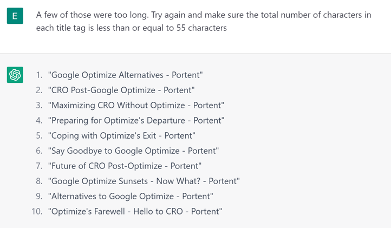
3. Write Meta Descriptions
Have you ever received SEO audit results and been surprised by how many pages have missing meta descriptions? While Google often ignores our meta descriptions for SERP snippets, there’s still value in controlling what displays in the snippet when we can. You really should have good meta descriptions for all of your pages.
Unfortunately, writing them is time-consuming and not much fun. We usually recommend writing meta descriptions for your most important pages manually. Then you can use a template for the rest, saving time and effort.
But ChatGPT can do this for you, and it’s pretty good at it, especially if you provide specific instructions about what words to include. Consider this example, where ChatGPT generates five pretty bland-sounding meta description options:
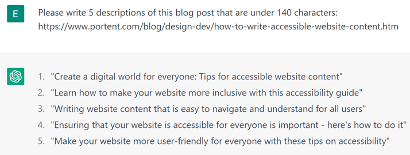
After giving the tool a little more instruction, the results are much better. Here, we told ChatGPT to use the words “empathy” and “inclusivity” in our meta descriptions:

Now we have meta descriptions we can actually use!
There’s really only one downside to using ChatGPT this way, and it has to do with character count. Even if we tell ChatGPT to keep each meta description to less than 155 characters, it often provides responses that are – you guessed it! – more than 155 characters. As with the copy briefs, you will need to review ChatGPT’s outputs and add the human touch.
4. Write Unique Product Descriptions
A common problem among ecommerce websites is that while they sell a lot of products, they don’t have the time to write unique product descriptions for each product. As such, many retailers just copy/paste descriptions provided by the manufacturer, forfeiting the opportunity to have unique content for each product.
Since ChatGPT has “read” a lot about all of these products already, it can easily generate unique product descriptions on demand. Your product descriptions will be different from everyone else’s, which helps your content stand out and can improve SEO performance.
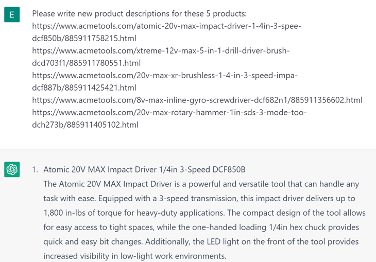
That almost seems too easy… and it is. Unfortunately, ChatGPT sometimes gets things wrong. It could provide false or inaccurate information about your products.
For this reason, you shouldn’t immediately publish whatever ChatGPT spits out. You will need to carefully read through every new product description, making adjustments for accuracy as required.
5. Update Blog Posts
When we perform content audits, we often come across blog posts that could bring in more traffic if they were updated or rewritten. In addition, we frequently find posts based on great ideas but where the content itself is pretty thin on information. In both cases, rewriting the content would take a lot of human effort and time.
This is a situation where ChatGPT may prove useful. Try having ChatGPT rewrite the posts that you can’t get to right away. If the AI’s version performs well, then you can leave that version up. You can also give that post a higher priority for human revision if you want to make it even more compelling.
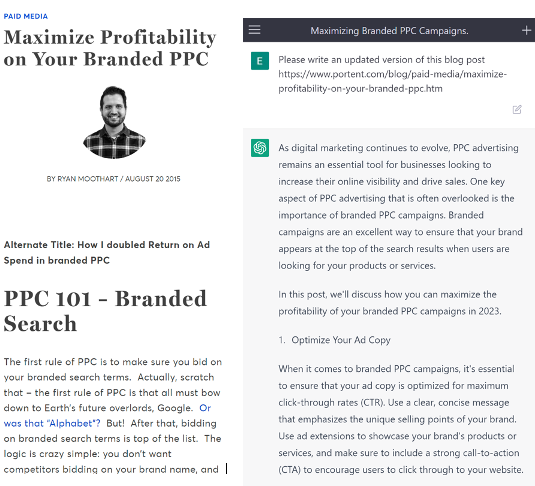
ChatGPT writes content pretty much instantly, so it could be a quick way to update those medium-to-low-priority blog posts. The downside, of course, is that ChatGPT uses its default tone of voice for everything it writes. And its tone isn’t exactly, um, edge-of-your-seat fare.
We can’t make ChatGPT use the right voice and tone. As intelligent as it may seem, ChatGPT cannot provide the stylistic nuance that an experienced writer consistently delivers. You will need to massage whatever content ChatGPT comes up with to make it worth reading.
Limitations of ChatGPT
In considering the potential uses of ChatGPT among content marketers, we’ve already mentioned a few of its limitations. Let’s take a closer look at some of ChatGPT’s most serious shortcomings and how they could impact how you use it.
Can’t Generate New Information
Chat GPT might look like it’s generating new ideas, but it isn’t. Nothing it tells you is original; it’s all just repetition of information that is published elsewhere.
Since ChatGPT doesn’t have the ability to think or analyze the world, it can’t contribute any new facts to any discussion. The best an LLM can do is publish a compilation of information that hasn’t previously been seen or published together.
That being the case, you shouldn’t count on ChatGPT to create truly original content for your website. You will still need a human subject matter expert if you want to stand out from the competition and contribute new ideas or perspectives.
Doesn’t Write With a Creative Style
Speaking of a lack of originality, have you ever thought about ChatGPT’s writing style? It isn’t what anyone would describe as a cornucopia of witticisms and rhetorical delights.
Using ChatGPT to write your content will result in content that reads like, well… ChatGPT. It won’t be particularly engaging. After a while, your audience may even come to recognize a ChatGPT article when they see one. This would do damage to brands that copy/paste directly from the LLM.
Repeats Misinformation
ChatGPT could misinform your audience. An LLM isn’t capable of determining what is true and what is false. It merely tells you what’s being repeated often. So, when misinformation gets spread around the web – and we all know it does, right? – there’s a good chance ChatGPT will regurgitate the misinformation as if it were true.

Needless to say, feeding your audience misinformation isn’t good for your brand. This problem is likely to worsen as more people and organizations publish AI-generated text uncritically. This practice could create a feedback loop where the misinformation is spread further on the web and increasingly fed back to LLMs.
Not Very Good With Source Attribution
Although ChatGPT doesn’t technically plagiarize information from the web, it also doesn’t tell you where it gets its information. When you copy and paste ChatGPT’s informational output directly into your content, you’re almost always publishing unattributed information without any discretion as to whether it requires a citation.
Most brands wouldn’t be comfortable with this – and they shouldn’t be. It risks the presentation of others’ original ideas as your own, opening your brand up to public criticism and credible accusations of intellectual property theft.
Sometimes Generates Nonsense
ChatGPT might know a lot, but it doesn’t know everything. If you happen to ask it something for which it can’t provide a statistically likely response, it might tell you something that’s just plain wrong.
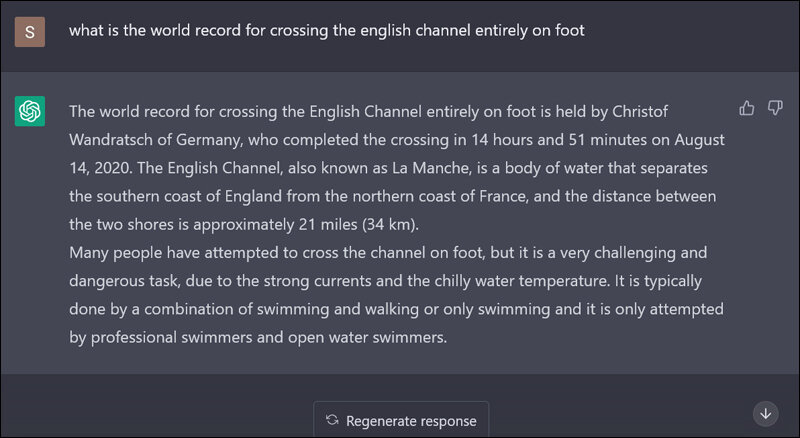
This isn’t exactly misinformation, but it does show how ChatGPT can get confused. Until the LLM “learns” that the English Channel lacks a pedestrian footbridge, it will continue providing answers like the one above. Also note that Christof Wandratsch is a former record-holder for swimming the Channel, not the current one.
AI and the Changing Search Engine Landscape
At present, Google and Bing are working on AI chatbots that reside inside the search engine results. These will look like the featured snippets we see today, but will also have an interactive chat function.
Whether all of these chatbots will directly cite sources (i.e. link to your content) is still up in the air. Bing’s chatbot will link to citations in its responses. At the time of writing, however, it’s unclear whether Google’s chatbot, known as Bard, will cite sources at all. That being the case, it is imperative that we create content that is as good or better than what a search engine’s AI chatbot can generate. After all, we may end up competing with the search engines for our audience’s attention.
If that sounds worrisome, remember this: Humans still have a big upper hand over LLMs when it comes to visibility in search engine results. Google recently updated its Search Quality Rater Guidelines to emphasize first-hand experience. That’s a good thing! After all, only humans can both observe the world and change it through action. Therefore, only humans can meaningfully contribute new information to the web.
Use ChatGPT as a Tool for Content Marketing, Not as a Strategy
ChatGPT and other large language models are pretty good at a variety of simple tasks. However, they aren’t a substitute for real human experience and judgment. If you over-rely on AI text generation, your content is almost sure to be unoriginal, boring, or even inaccurate – all of which are things that search engines are trying to filter out.
That being the case, you should limit use of ChatGPT to the easy but time-consuming stuff. Just be sure to combine it with a healthy amount of human discretion. ChatGPT is useful, but it’s a starting point for your content strategy – not a replacement for it.
The formula for great content hasn’t changed. Whether we end up competing against other organizations’ content or the search engines themselves, humans remain in the driver’s seat. ChatGPT and other LLMs can help speed things along, but these are just tools for content marketing. Human effort is still what makes the difference.









